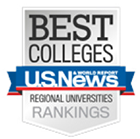
-
Scholarships*

First, we subtract scholarships.
$9,839: Average scholarship per RIT/NTID student


-
Grants*

Next, we subtract grants.
$2,763: Average grant awarded per RIT/NTID student


-
Vocational Rehabilitation (VR) and Federal Work Study*

Finally, we subtract VR and Federal Work Study.
$7,302: Average VR and Federal Work Study support per RIT/NTID student


-
Average Actual Cost
What we're left with is the actual cost, oftentimes significantly less than the original total cost of attendance.

*Based on 2022-23 academic year data












